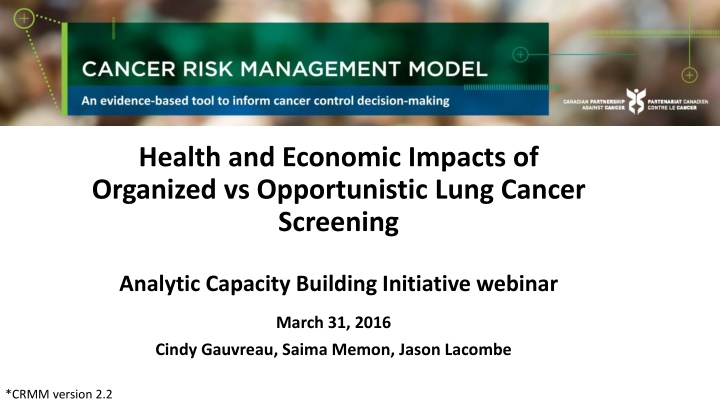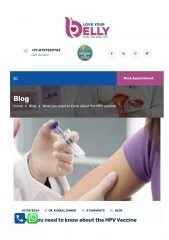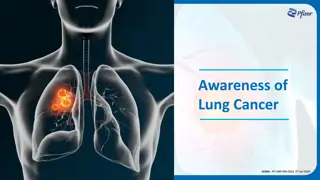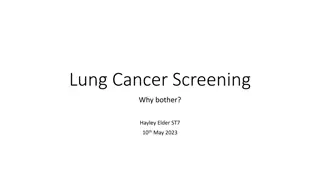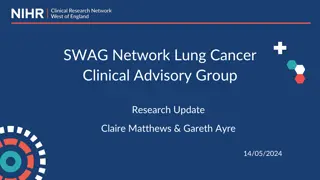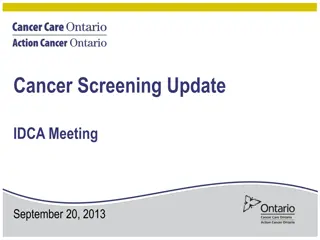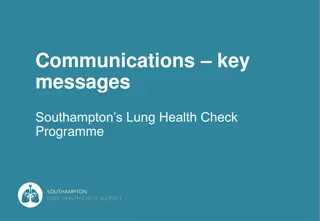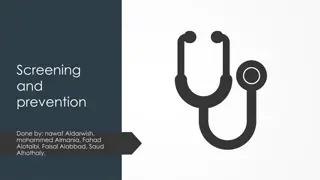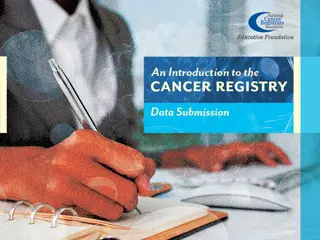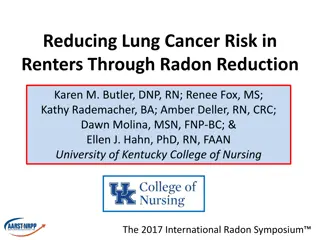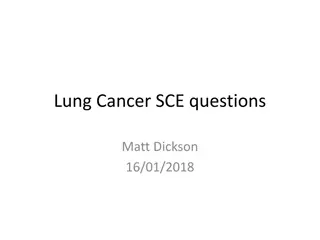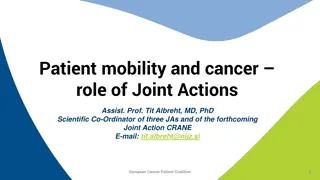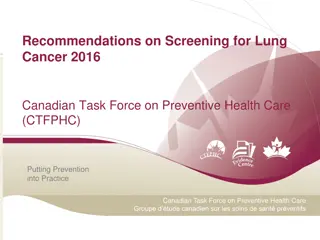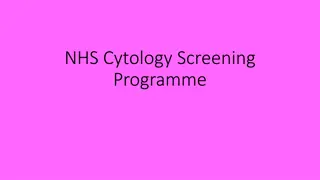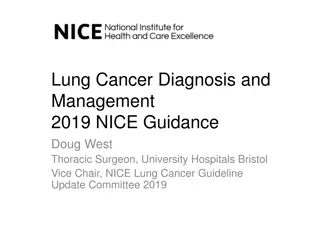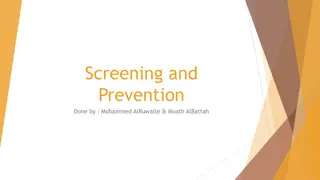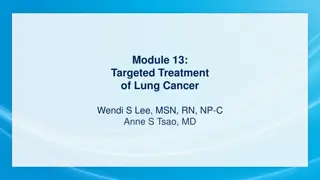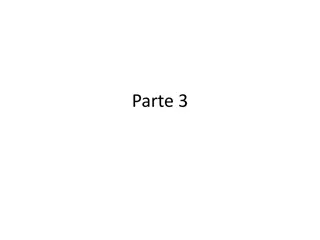Health & Economic Impacts of Lung Cancer Screening
This webinar delves into the health and economic impacts of organized vs opportunistic lung cancer screening, analyzing scenarios, outcomes, and guidelines in Canada and the US. Explore the burden of lung cancer, the efficacy of LDCT screening, and the implications of non-adherence to screening recommendations.
Download Presentation

Please find below an Image/Link to download the presentation.
The content on the website is provided AS IS for your information and personal use only. It may not be sold, licensed, or shared on other websites without obtaining consent from the author.If you encounter any issues during the download, it is possible that the publisher has removed the file from their server.
You are allowed to download the files provided on this website for personal or commercial use, subject to the condition that they are used lawfully. All files are the property of their respective owners.
The content on the website is provided AS IS for your information and personal use only. It may not be sold, licensed, or shared on other websites without obtaining consent from the author.
E N D
Presentation Transcript
Health and Economic Impacts of Organized vs Opportunistic Lung Cancer Screening Analytic Capacity Building Initiative webinar March 31, 2016 Cindy Gauvreau, Saima Memon, Jason Lacombe *CRMM version 2.2
Acknowledgements Bill Evans (Lead, Lung Cancer Model Working Group) Andy Coldman Anthony Miller John Goffin William Flanagan Claude Nadeau Keiko Asakawa Michael Wolfson Nicole Mittmann Heather Bryant Gina Lockwood Sharon Fung The Cancer Risk Management Model is funded by Health Canada through the Canadian Partnership Against Cancer 2
Objectives To introduce Canadian/US lung cancer screening guidelines To familiarize the audience with the Partnership s Cancer Risk Management Model (CRMM) and its application to lung cancer screening policy questions To demonstrate some health and economic impacts of non-adherence to Canadian lung cancer screening recommendations To pose questions for data analysts in the context of preparing for programmatic lung cancer screening
Outline 1. Introduction to Canadian and US public health guidelines for lung cancer screening 2. The CRMM lung cancer model 3. Scenarios for organized vs opportunistic screening 4. Comparative health outcomes 5. Comparative economic outcomes 6. Summary, conclusions, questions 4
1. Canadian and US public health guidelines for lung cancer screening 5
Lung cancer burden, 2012 Lung cancer is the most common cancer in the world Among cancers, it is the leading killer Incidence rate per 100,000 ASR-W* (Crude) Mortality rate per 100,000 ASR-W* (Crude) World 23.1 (25.9) 19.7 (22.5) Canada 37.9 (73.5) 28.4 (58.0) United States 38.4 (67.8) 28.6 (53.1) * Age-standardized to the world population. Source: GLOBOCAN 2012
Compelling effect of LDCT screening on lung cancer mortality Randomized controlled trial showed LDCT screening compared to conventional chest X-rays reduced mortality by 15 - 20% (US National Lung Screening Trial, 2002- 2004) 7
Recommendations for lung cancer screening in Canada and the United States Canadian Task Force on Preventive Health Care (CTFPHC) (2016) U.S. Preventive Services Task Force (2013) Smoking history of at least 30 pack years Currently smoke or quit less than 15 years ago Annual LDCT screening up to three consecutive times 55 to 74 years Annual LDCT screening 55 to 80 years old Weak recommendation Grade B evidence CTFPH Lung Cancer Screening Guidelines http://canadiantaskforce.ca/ctfphc-guidelines/2015-lung-cancer/ USPSTF Lung Cancer Screening Guidelines http://www.uspreventiveservicestaskforce.org/Page/Document/UpdateSummaryFinal/lung-cancer-screening 8
Benefit-risk weighing - CTFPHC The CTFPHC based the recommendations on the overall balance between the possible benefits and harms of screening for lung cancer, weighing the potential benefits of early disease detection against the harms of overdiagnosis and invasive follow up testing. Benefits: LDCT scans are more able to pick up small masses compared to old technology of conventional chest x-rays using smaller doses of radiation Risks: identifies many masses that may never progress to cancer, but incurs follow ups of biopsies, etc. that have their own risks 9
Benefit-risk weighing - USPHTF The USPSTF recommends the service. There is high certainty that the net benefit is moderate or there is moderate certainty that the net benefit is moderate to substantial. Benefits: Early detection leading to reduction in mortality (15 - 20% in NLST) Risks: Radiation exposure, overdiagnosis, false positives (96.4% in NLST) 10
Cancer Risk Management Model Risk Factors PREVENTION Age PRIMARY Lifestyle Environmental Presence of virus Outcomes Cancer Year Incidence Deaths Resource needs Direct health care costs Life expectancy Health-adjusted LE Economic impacts Screening DETECTION Natural history Sex Incidence Target populations Participation rates Various modalities EARLY Treatment Progression Case-fatality New Treatment Province SECONDARY PREVENTION Cost Survival Health utility Incremental Cost-effectiveness Ratios (ICERs) Other cause mortality 12
How does microsimulation work? (non (non- -interacting agent approach) interacting agent approach) Let s start with one simulated person (who happens to get lung cancer) Terminal Care ? Distant recurrence ? Age 0 Age 1 Age 15 Age 56 On-going care Male Treatment Remission Trt Cumulative cigarette smoking Starts smoking Lung cancer diagnosed at age 56.8 Case- Fatality Stage II Method*: (1) Calculate the probability from age-sex specific baseline incidence rate multiplied by relative risk associated with smoking and radon Increased risk of lung cancer (2) Draw random number (3) If random number less than probability, cancer is diagnosed *actually, we convert the probability to a hazard and draw a waiting time 13
3. Scenarios for organized vs opportunistic screening 14
Scenario Terms and Definitions Organized screening = programmatic screening adhering to CTFPH guidelines Opportunistic screening = non-programmatic screening (screening outside guidelines) Pack-year a measure of smoking history based on the number of packs (20 cigarettes/pack) smoked per day and number of years of smoking 30 pack-year history = 1 pack/day * 30 years =10 packs/day * 3 years = 2 packs/day * 15 years Participation rate percent coverage of the eligible population 15
Types of scenarios Organized screening of high-risk individuals with only 3 scans (CTFPH guidelines), with moderate and high participation rates Opportunistic screening of low risk individuals (young and light smokers) and high risk individuals annually, with moderate and high participation rates 16
Key Scenario Assumptions SCREENING VARIABLE ORGANIZED SCREENING OPPORTUNISTIC SCREENING Screening age 55 74 years 40 84 years Screening frequency 3 annual screens Annual Smoking history 30 pack-year 1 or 30 pack-year Participation rate a) 30% b) 60% a) 30% b) 60% Follow-up and efficacy Cessation intervention Based on NLST Based on NLST None None 17
Key Cost Assumptions (CAD$ 2008) Cost of Screening Scan Screening test (LDCT scan) Screening test interpretation Consultation and Communication fees Communication cost for screen result Consultation for positive test Diagnostic Investigation of Positives Non-invasive diagnostic procedures for positive screen Invasive procedure for positive screen Treatment Diagnostics Pre-diagnosis (GP) Diagnosis (specialist) Treatments Surgery Adjuvant Chemotherapy Radiotherapy Chemotherapy * Includes: Diagnostics and physician fees **Includes: Diagnostics, hospital admission, physician fees, drug costs, and other professional consultations 81 88 31 163 220 1,583 220* 1,207* 13,848** 3,196** 4,628** 3,080** 18
Average Annual Screens (2016-2036) Applying Canadian and United States recommended guidelines 30% and 60% participation rates* 450,000 Average annual screens 400,000 350,000 300,000 250,000 200,000 150,000 100,000 50,000 0 CAN Org: 55-74yrs, 30% CAN Org: 55-74yrs, 60% USPSTF Org: 55-80yrs, 30% UPSTF Org: 55-80yrs, 60% *30 pack-years 20
Average Annual Screens (2016-2036) Organized vs opportunistic screening Various participation rates and smoking history 2,000,000 (B) 60% Participation (A) 30% Participation 1,800,000 Average annual screens 1,600,000 1,400,000 1,200,000 1,000,000 800,000 600,000 400,000 200,000 0 Org: 30% 30pk yr Opp: 30% 1pk yr Opp: 30% 30pk yr Org: 60% 30pk yr Opp: 60% 1pk yr Opp: 60% 30pk yr 21
Lung Cancer Incident Cases (2016-2036) Organized vs opportunistic screening Various participation rates and smoking history 33,000 32,000 Lung cancer incident cases 31,000 30,000 29,000 Org: 30% 30pk yr Opp: 30% 1pk yr Opp: 30% 30pk yr Org: 60% 30pk yr Opp: 60% 1pk yr Opp: 60% 30pk yr 28,000 27,000 26,000 2016 2021 2026 2031 2036 22 *non-age standardized
Lung Cancer Deaths (2016-2036) Organized vs opportunistic screening Various participation rates and smoking history 25,500 25,000 24,500 Lung cancer deaths 24,000 23,500 23,000 Org: 30% 30pk yr Opp: 30% 1pk yr Opp: 30% 30pk yr Org: 60% 30pk yr Opp: 60% 1pk yr Opp: 60% 30pk yr 22,500 22,000 21,500 21,000 2016 2021 2026 2031 2036 23 *non-age standardized
Average Annual Incidence and Mortality Rates (2016-2036)* Incidence rate (per 100,000) Org: 30% 30pk yr 77 Opp: 30% 1pk yr 79 Opp: 30% 30pk yr 78 Org: 60% 30pk yr 77 Opp: 60% 1pk yr 82 Opp: 60% 30pk yr 81 No screening 76 Mortality rate (per 100,000) 63 61 62 62 60 61 63 Scenario Note: Crude rates, not age-standardized 24
Average Annual Invasive Diagnostics for False Positives (2016-2036) Organized vs opportunistic screening Various participation rates and smoking history 7000 Average annual invaisive diagnostics 6000 5000 4000 3000 2000 1000 0 Opp: 60% 1 pk yr Opp: 30% 1pk yr Opp: 60% 30pk yr Opp: 30% 30pk yr Org: 60% 30pk yr Org: 30% 30pk yr 25
5. Comparative economic outcomes 26
Average Annual Costs (2016-2036)* Organized vs opportunistic screening Various participation rates and smoking history Billions $1.6 $1.4 Cost of screening Cost of treatment $1.2 Average annual costs $1.0 $0.8 $0.6 $0.4 $0.2 $0.0 Opp: 60% 1pk yr Opp: 30% 1pk yr Opp: 60% 30pk yr Opp: 30% 30pk yr Org: 60% 30pk yr No Screening 27 * CAD$ 2008
Total Costs per Year (2016-2036)* Organized vs opportunistic screening 30% Participation rate Various pack-years 60% Participation rate Various pack-years 1.85 1.85 Org: 30pk yr 1.65 Opp: 1pk yr 1.65 Billions ($CAD) Opp: 30pk yr Billions ($CAD) 1.45 1.45 1.25 1.25 1.05 1.05 0.85 0.85 0.65 0.65 2016 2021 2026 2031 2036 2016 2021 2026 2031 2036 * CAD$ 2008 28
Difference of Total Costs (2016-2036) Opportunistic compared to organized screening Average Annual Difference ($) Total Cumulative Difference ($) Scenario Org: 60%, 30 pk yr* N/A N/A Opp: 30%, 1 pk yr 289,197,825 6,073,154,328 Opp: 30%, 30 pk yr 62,543,959 1,313,423,140 Opp: 60%, 1 pk yr 615,902,959 12,933,962,134 Opp: 60%, 30 pk yr 173,938,631 3,652,711,254 * Indicates reference category. Costs are in CAD$ 2008 29
Cost-effectiveness analysis can help sort out competing choices Cost-effectiveness provides a sense of value for money Incremental cost-effectiveness analysis compares a new intervention to a relevant comparator, e.g. standard care or lack of care The incremental cost-effectiveness ratio (ICER) compares the net costs to the net benefits of the compared interventions 30
QALYs a standardized measure of benefit or effectiveness Quality adjusted life years (QALYs) puts comparison between interventions on the same footing It is a composite measure of morbidity and mortality Often used as the denominator in ICERS 31
Incremental Cost-effectiveness of Various Scenarios Compared to No Screening 30% participation, various pack-years Cost difference compared to No screening $16 No Screening Billions $14 CAD Org: 55-74yrs, 30% 30pk yr $12 $10 Opp: 30% 1pk yr $8 Opp: 30% 10 pk yr $6 Opp: 30% 20 pk yr $4 $2 Opp: 30% 30pk yr $0 0 20000 Gain in quality-adjusted life-years (QALYs) 40000 60000 80000 32 * 3% discount
Incremental Cost-effectiveness of Various Scenarios Compared to No Screening 60% participation, various pack-years Cost difference compared to No screening $30 Billions No Screening $25 CAD Org: 55-74yrs, 60% 30pk yr Opp: 60% 1 pk yr $20 $15 Opp: 60% 10pk yr $10 Opp: 60% 20pk yr $5 Opp: 60% 30pk yr $0 0 50000 Gain in quality-adjusted life-years (QALYs) 100000 150000 200000 33 * 3% discount
6. Summary, conclusions, questions 34
Summary Comparisons Opportunistic vs organized screening, various participation, 30 pack-years ICER* (COST/QALY COMPARED TO NO SCREENING) (in CAD$, discounted 3%) AVERAGE ANNUAL INCIDENT CASES AVERAGE ANNUAL DEATHS AVERAGE ANNUAL SCREENS AVE. ANNUAL TOTAL COST (2008 CAD$) SCENARIO Organized 60% 29,094 23,554 122,113 815,029,000 68,330 Opportunistic 30% 29,555 23,292 286,539 877,573,000 71,960 Opportunistic 60% 30,327 22,861 573,693 988,968,000 70,200 35 *INCREMENTAL COST-EFFECTIVENESS RATI0, LIFETIME HORIZON, HEALTH SYSTEM PERSPECTIVE
Conclusions Opportunistic screening outside of CTFPH guidelines may detect more lung cancer cases and prevent more deaths than organized screening adhering to CTFPH guidelines, but may also generate more risks such as excessive false positives and accompanying invasive diagnostic procedures Opportunistic screening would very likely be more costly and less cost- effective than organized screening adhering to CTFPH guidelines If indirect costs and costs of harms were included, opportunistic screening would be even less cost-effective than projected 36
Key Limitations Costs are mainly based on Ontario clinical and health services costs, some dating to 2008 The efficacy of LDCT for younger and older age groups was assumed to be the same as for the target age group for organized screening (55-74 years old) Results are not age-standardized 37
Questions to the audience please take home, or share your thoughts now through webinar Are data for lung screening programs different from that of other screening programs, or for other cancer control programs? How are they different? Consider: Tobacco use (prevalence, age of initiation, smoking history, mitigation/cessation) Demand for tobacco Occupational hazards Environmental hazards Tobacco treatment utilization and costs How have you made the case for needed resources (data, personnel) to your managers for a lung screening program? What kinds of data do you think you will need? What are the potential sources? How will you get them? How can data analysts and program managers/directors work together to determine their data needs? How can you engage with researchers to obtain and analyse data? 38
Thank you CONTACT US: Email: riskmgmt@cancerview.ca Web: www.cancerview.ca/cancerriskmanagement 39
Appendix 40
Variable Price (CAD $) Detailed unit costs (1) Recruitment* Physician recruitment Cost of Screening Scan Screening Test (LDCT scan) Screening test interpretation Consultation and Communication fees Communication cost for screen result (positive or negative) 31 81 88 Notes: *Fixed overhead and promotion costs not included. **Non-invasive procedures include additional LDCT, CXR, PET scans). *** Includes Bronchoscopy, Mediastinoscopy, Thoroscopy, Biopsy. Minimally invasive surgical wedge resection not included here as would be part of the diagnostic workup already covered in treatment management algorithm. Cost of complications not included. 31 Consultation for positive test Diagnostic Investigation of Positive s Non-invasive diagnostic procedures for positive screen** Invasive procedure for positive screen*** Treatment Diagnostics Pre-diagnosis (GP) 163 220 1583 Diagnostics: 67 Physician: 153 Diagnostics: 921 Physician: 286 Diagnosis (specialist) Treatments Surgery Diagnostics: 53 Hospital: 12533 Physician: 1262 Diagnostics: 228 Hospital: 430 Physician: 778 Drug: 896 Other professional: 496 Other: 368 Adjuvant Chemotherapy Radiotherapy Physician: 855 Radiotherapy: 3773 Diagnostics: 128 Hospital: 430 Physician: 538 Drug: 1180 Other professional: 480 Other: 324 Chemotherapy 41
Surveillance Detailed unit costs (2) Year 1 Diagnostics: 229 Physician: 216 Diagnostics: 229 Physician: 216 Diagnostics: 114 Physician: 183 Diagnostics: 114 Physician: 183 Diagnostics: 114 Physician: 183 Year 2 Year 3 Year 4 Year 5 Palliative Supportive care only (palliative radio) Diagnostics: 20 Hospital: 250 Physician: 471 Radiotherapy: 629 Other professional: 40 Other: 36 Supportive care only (on-going care) End of life care 3 months before death Physician: 25 Hospital: 1612 Physician: 187 Drug: 144 Radiotherapy: 55 Other: 55 End of life care 2 months before death Hospital: 3224 Physician: 375 Drug: 287 Radiotherapy: 110 Other: 109 End of life care 1 month before death Hospital: 5911 Physician: 687 Drug: 527 Radiotherapy: 201 Other: 200 42
How the model has been used Canadian Cancer Society, Canadian Cancer Statistics, 2015 Projections of lung, colorectal and cervical cancer screening impact using CRMM www.cancer.ca Alberta STE* Report, Institute of Health Economics Impact of low dose computed tomography for the screening of lung cancer in adults www.health.alberta.ca Canadian Task Force on Preventive Health Care Guidelines Colorectal cancer screening (released February 2016) Lung cancer screening (released March 2016) Canadian Partnership Against Cancer System Performance Spotlight Report (to be released March 2016): Quality and Sustainability in Cancer Control impacts of inappropriate surgery in stage IV breast and colorectal cancer National screening networks support Cervical, Colorectal, Lung and Breast Screening Networks *STE = Social and System Demographics Analysis, Technology Effects and Effectiveness, Economic Analysis 44
Main Data Sources Data Type Source Mortality, Birth, Population projections Vital Statistics (1950-2005), Census (2006, 2011) Incidence, Staging (Survival) Canadian Cancer Registry (1992-2010) Cancer survival by stage British Columbia Cancer Registry Data (1992-2012) Chart review (1991-92), Literature (1981, 1990-2000, 2005) Smoking rates Canadian Community Health Survey (CCHS) (2000-2007) National Population Health Survey (1994-2004) Canadian Health Survey (1979) Time use data General Social Survey (2005) Earnings, Transfers, and Taxes Census 2006, SPSD/M v16.1 (2005) Total health care expenditures Canadian Institute for Health Information (2006) Health care costs: diagnosis, treatment, follow-up, palliative and terminal care Ontario Case Costing Initiative (2007-2008) Provincial formulary (2009) Provincial Ministries of Health (2009) Current treatment practice Expert Opinion, Ontario administrative data Screening, Lung cancer risk equation, Radon exposure, sexual network, HPV virus transmission Canadian Breast Cancer Screening Database, British Columbia administrative data, CCHS, Reports, Literature Health status Classification and Measurement System, CCHS 45
CRMM Publications (10) FOUNDATIONAL Evans WK, Wolfson MC, Flanagan WM, et al. Canadian Cancer Risk Management Model: Evaluation of cancer control. Int J Technol Assess Health Care. 2013 Apr; 29(2):131-9. LUNG CANCER Evans WK, Wolfson M, Flanagan WM, et al. The evaluation of cancer control intervention in lung cancer using the Canadian Cancer Risk Management Model. Lung Cancer Manage. 2012; 1(1):25-33. Louie AV, Rodrigues GB, Palma DA, et al. Measuring the population impact of introducing stereotactic ablative radiotherapy for stage I non-small cell lung cancer in Canada. Oncologist. 2014 Aug; 19(8):880-5. Fitzgerald NR, Flanagan WM, Evans WK, et al. Eligibility for low-dose computerized tomography screening among asbestos-exposed individuals. Scand J Work Environ Health. 2015 Apr. Flanagan WM, Evans WK, Fitzgerald NR, et al. Performance of the Cancer Risk Management Model lung cancer screening module. Health Reports. 2015 May; 26(5). Goffin JR, Flanagan WM, Miller AB et al. The Cost-Effectiveness of Lung Cancer Screening in Canada. JAMA Oncology; 2015;1(6):807-813 Evans WK, Flanagan WM, Miller AB, et al. Implementing Low Dose CT Screening for Lung Cancer in Canada: Implications of Alternative At Risk Populations, Screening Frequency and Duration. Accepted for publication to Current Oncology COLORECTAL CANCER Coldman AJ, Phillips N, Brisson J, et al. Evaluating colorectal cancer screening options for Canada using the Cancer Risk Management Model. 2015 Apr; 22(2):e41- 50. CERVICAL CANCER / HPV Miller AB, Gribble S, Nadeau C et al. Evaluation of the Natural History of cancer of the cervix, implications for prevention. The Cancer Risk Management Model (CRMM)- Human PapillomaVirus and Cervical components. Journal of Cancer Policy 4 (2015) 1 6. Popadiuk C, BhavsarM, Wolfson MC, et al. Evaluating the health and economic impact of cytology versus primary HPV DNA cervical cancer screening in Canada using the Cancer Risk Management Model (CRMM). Curr Oncol. 2016 Feb; 23(Suppl 1): S56 S63. 46
